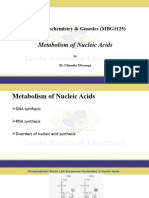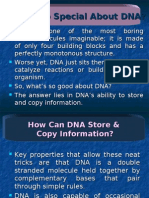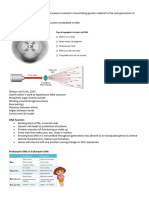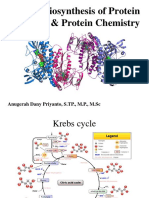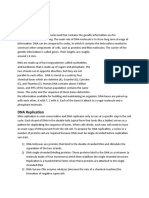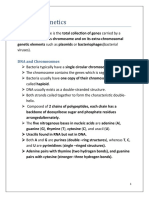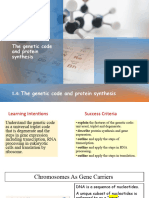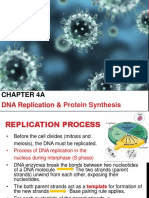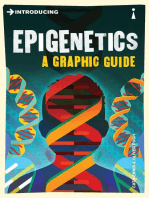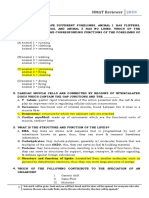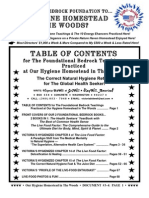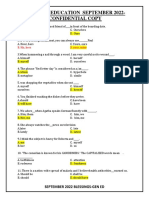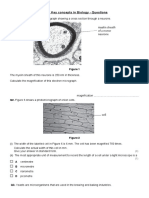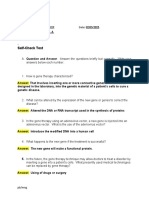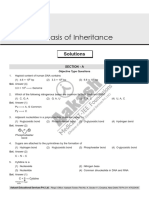Lecture 24-28
Lecture 24-28
Uploaded by
Qᴜʀᴀᴛ Uʟ AɪɴCopyright:
Available Formats
Lecture 24-28
Lecture 24-28
Uploaded by
Qᴜʀᴀᴛ Uʟ AɪɴCopyright
Available Formats
Share this document
Did you find this document useful?
Is this content inappropriate?
Copyright:
Available Formats
Lecture 24-28
Lecture 24-28
Uploaded by
Qᴜʀᴀᴛ Uʟ AɪɴCopyright:
Available Formats
General Science (GSC101)
LECTURE # 33
Biology Lecture # 05
CHROMOSOMES, DNA AND GENES
Heredity Information Flow
Reproducing itself is a property of life. Transferring characteristics to next generation is a
property of living organisms. Heredity information flow in living organisms is carried out
by the genes. The “Chromosome theory of heredity” states that the genes are present on
chromosomes and are responsible for the transfer of characteristics from generation to
generation. Genes are present in the form of DNA molecules, organized in a structure
called chromosome (chromatin material).
Chromatin - the Genetic Material
Genetic material is present in the nucleus of the cell in eukaryotes and in the nucleoid
region in prokaryotes. These are called chromatin material. Chromatin material is not
visible during interphase (non-dividing state) of the cell. These become visible during
cell division due to condensation of chromosomes.
Functions of Genetic Material
There are some important properties of genetic material, which are following:
• It replicates itself.
• It regulates the growth and development of the organism.
• It allows the organism to adapt to the environmental changes.
Chromosomes - DNA – Genes
Chromosomes consist of DNA molecule associated with proteins. In chromosomes, DNA
is wrapped around proteins. Few of these proteins are called histones and few others.
DNA is associated with histone and non-histone proteins in a chromosome.
Introduction of DNA and Gene
DNA is a macromolecule (large molecule) organized in structure chromosome. In
prokaryotes DNA is a circular molecule. In eukaryotes it is a long linear molecule.
Mitochondria and chloroplast also have their own circular DNA molecules.
Gene is a length of DNA that codes for a peptide or protein. So that gene is a part or
length of DNA.
© Copy Rights Virtual University of Pakistan Page 1
General Science (GSC101)
Condensation of Genetic Material
Chromatin material condenses during prophase of mitosis in the form of chromosomes.
Chemical analysis shows that chromosome consist of DNA and proteins. DNA is a long
molecule about 2nm thick running continuously within each chromosome. Chemical
analysis shows that DNA is acidic in nature.
The Structure of Chromosomes
Chromosome consists of a DNA molecule wound around proteins. DNA in human cell
(all chromosomes) is about 6 feet long, packed in a microscopic nucleus of a cell. In one
human chromosome, it is 1.7-8.5 cm long. How is this possible? The answer is “coiling”
and “super-coiling”. The chromosome consists of highly condensed structure. If we can
open this like a thread, then the long thread will appear like a flower like structure called
solenoid which consists of many smaller units. These small units are called
“nucleosomes”. A nucleosome is a length of DNA coiled around a set of proteins. The
DNA coils around histones twice, which is up to 200 base pairs long. Two nucleosomes
are connected to each other by a length of DNA, which is called “linker DNA” (up to 80
base pairs long).
Chromosome coiling and nucleosome
© Copy Rights Virtual University of Pakistan Page 2
General Science (GSC101)
Two nucleosomes
Chemical Composition of DNA
DNA is a complex macromolecule (large molecule). DNA stands for Deoxyribose
Nucleic Acid. The smallest unit of DNA is called a “nucleotide”; nucleotides join to
make polynucleotide. We can say that DNA consists of nucleotides joined together.
Nucleotides
Each nucleotide consists of:
1. Deoxyribose sugar
2. Phosphate group
3. Nitrogenous base
phas
Ana
Meta
phas Telophase
e
Structure of a nucleotide
There are four nucleotides based upon four different nitrogenous bases attached to them.
Nitrogenous bases are of two types: purines and pyrimidine. Purines include two bases
© Copy Rights Virtual University of Pakistan Page 3
General Science (GSC101)
Adenine and Guanine which have a double ringed structure. Pyrimidine bases include the
other ones called Thymine and Cytosine that have single ringed structure.
Mechanism of Gene Action
Genes express themselves by making proteins. Making the proteins by DNA occur by
two processes called transcription and translation. Transcription is formation of a form
of RNA from DNA called messenger RNA (mRNA). mRNA is formed inside the nucleus
in eukaryotes and in nucleoid region in prokaryotes. The next process is translation,
which is formation of a protein or peptide by mRNA with the help of another organelle
called ribosome.
Replication is another function of DNA. It is doubling of DNA molecule to make two
copies of itself. Replication occurs before cell division to make copies of DNA for the
daughter cells.
Genetic code is a term used for the parts of DNA that code for proteins. A codon is a 3
nucleotides code for an amino acid, i.e., codon is a 3 nucleotide set of DNA molecule that
codes for a protein.
Transcription and Translation
• Transcription = DNA mRNA
• Translation = mRNA Protein
• The following scheme is called the central dogma of molecular biology / genetics
DNA RNA Protein
Transcription
• DNA mRNA
The process of transcription involves an enzyme called RNA polymerase. One strand of
DNA act as the template strand which is actually coded into the mRNA.
• Steps of transcription
o RNA polymerase identifies and attaches to a region called promoter on the
DNA upstream the gene.
o RNA polymerase open the double helix chain which results in the
formation of transcription bubble.
© Copy Rights Virtual University of Pakistan Page 4
General Science (GSC101)
Deoxyribose sugar
P
Transcription Process
• RNA polymerase moves on the gene, the helix unwinds and make a
complementary strand of RNA. This strand of mRNA protrudes out of
transcription bubble.
• At end of the gene there is a stop sequence. Usually it is a series of GC
base pairs followed by a series of AT base pairs.
• These sequences make a hair pin loop like structure which stops RNA
polymerase from transcribing.
• Thymine is coded as uracil in mRNA.
Promoter region on
DNA
© Copy Rights Virtual University of Pakistan Page 5
General Science (GSC101)
Transcription in Prokaryotes and Eukaryotes
In prokaryotes, the mRNA directly moves into cytoplasm and its translation starts
because there is no nuclear membrane, nucleoid region is continuous with cytoplasm. In
eukaryotes, mRNA formed moves out of nucleus through nuclear pores and then it is
translated in the cytoplasm with the help of ribosomes.
Modification of mRNA in eukaryotes
mRNA in eukaryotes has to travel from nucleus to cytoplasm, to protect it from the action
of nucleases (the DNA cutting enzymes) and proteases (protein cutting enzymes), it is
modified. On its 5’ end a cap of 7 methyl GTP is added; while on the 3’ end a poly A tail
is added. Introns are also removed. Introns are DNA sequences in the eukaryotes which
are non coding and should be removed from the mRNA. The coding regions are called
exons.
mRNA formed RNA Polymerase
RNA Template
Gene: the coding region
polymerase strand
Exon
mRNA in eukaryotes have regions – exons and introns
Translation
• mRNA ------- Protein
The process of translation consists of three major steps: initiation, elongation, and
termination.
Steps of Transcription
• In prokaryotes, translation starts while transcription is going on because there is
no barrier between nucleoid and cytoplasm.
• In eukaryote, first introns are removed.
© Copy Rights Virtual University of Pakistan Page 6
General Science (GSC101)
Process of Translation
Initiation:
• The mRNA binds to the small unit of ribosome.
• The large ribosomal subunit has 3 binding sites called E (Exit), P (Peptidyl), and
A (Aminocyl).
• When the first codon (triplet code) is aligned at the P site then the large ribosomal
subunit attaches to the small subunit.
A ribosome
• A tRNA carrying the amino acid methionine attaches to the start codon (AUG) on
the messenger RNA.
A tRNA with an amino acid on the P site
© Copy Rights Virtual University of Pakistan Page 7
General Science (GSC101)
Elongation:
• A tRNA with its amino acid attaches to the A binding site.
• Peptide bond formation occurs between the methionine and the amino acid carried
at the A binding site.
• Ribosome moves in the 3' direction down the messenger RNA by three bases,
shifting the tRNA and polypeptide chain to the P Binding site.
• The A binding site is open and a vacant tRNA (without amino acid) is in the E
binding site.
• Now, the next tRNA brings another amino acid and bind to A site.
• A peptide bond is formed between the second and this new (thirs) amino acid.
• Ribosome moves in 3’ direction and the vacant tRNA is released from the E site.
• This process continues until a stop codon arrives on mRNA.
• A Releasing factor comes and binds to the A site in place of stop codon. The
polypeptide chain separates from tRNA and ribosome. Then ribosomal units
disassemble again. mRNA molecule also released which has been coded.
Peptide bond is formed between the amino acids brought by tRNAs present on P and A
sites.
© Copy Rights Virtual University of Pakistan Page 8
General Science (GSC101)
Growing polypeptide is present on P site and empty amino acid on E site. New
tRNA with an amino acid will come and attach on A site.
Exercise
1. Explain the process of transcription with the help of diagram.
2. Explain the process of translation with the help of diagrams.
3. Differentiate between the transcription and translation processes of prokaryotes
and eukaryotes.
© Copy Rights Virtual University of Pakistan Page 9
You might also like
- Replication, Transcription, Translation and Its Regulation: By, University of Agricultural Sciences, DharwadDocument42 pagesReplication, Transcription, Translation and Its Regulation: By, University of Agricultural Sciences, DharwadTabada NickyNo ratings yet
- Basics of Molecular BiologyDocument69 pagesBasics of Molecular BiologyYasin Putra Esbeye100% (2)
- Grade.9 - Non-Mendelian Pattern Inheritance AssesmentDocument8 pagesGrade.9 - Non-Mendelian Pattern Inheritance AssesmentPang ChixxNo ratings yet
- UMK Chapter 8 Sem 2Document40 pagesUMK Chapter 8 Sem 2Rina Abigail CarterNo ratings yet
- Biochem Protein SynthesisDocument35 pagesBiochem Protein SynthesisKeesha B. CañeteNo ratings yet
- Nucleic Acid Metabolism TAUDocument38 pagesNucleic Acid Metabolism TAUFaatimah EssaNo ratings yet
- (L-6) - Molecular Basis of Inheritance - Jan 25, 2020Document53 pages(L-6) - Molecular Basis of Inheritance - Jan 25, 2020AyazNo ratings yet
- Food Bioengineering: LIFS324Document96 pagesFood Bioengineering: LIFS324Dania LyewNo ratings yet
- Central Dogma of BiologyDocument28 pagesCentral Dogma of BiologyJabin Sta. TeresaNo ratings yet
- Chapter 6Document5 pagesChapter 6Abhishek Yadav RNo ratings yet
- Chapter 12 Biol1010 Notes-1-1Document4 pagesChapter 12 Biol1010 Notes-1-1yazst.julienNo ratings yet
- vac04106Document12 pagesvac04106edznajainaNo ratings yet
- Microbial GeneticsDocument17 pagesMicrobial Geneticsزين العابدين محمد عويش مشريNo ratings yet
- Phiên mã và dịch mãDocument35 pagesPhiên mã và dịch mãtrinhthungoct66No ratings yet
- L7S12. Central Dogma and Genetic Engineering - FDocument35 pagesL7S12. Central Dogma and Genetic Engineering - FSichayra GamotiaNo ratings yet
- Gene ExpressionDocument44 pagesGene Expression20.020 Cahya MaharaniNo ratings yet
- Coursenotesdomain 4 InformationDocument29 pagesCoursenotesdomain 4 Informationapi-300668314No ratings yet
- Transcription WorkingDocument51 pagesTranscription Workingapi-3858544No ratings yet
- Slide SHTB&GDocument91 pagesSlide SHTB&Gtrinhthungoct66No ratings yet
- Lecture 5 Chapter 9 Part ADocument31 pagesLecture 5 Chapter 9 Part Alinw73361No ratings yet
- K3 - Central DogmaDocument41 pagesK3 - Central DogmaAditya MuchayatsyahNo ratings yet
- DNA, RNA, Protein-Gene ExpressionDocument18 pagesDNA, RNA, Protein-Gene ExpressionFahim AbidNo ratings yet
- Gene Expression: Vikrant Joshi F.Y. Biotechnology 6519 Khalsa College AmritsarDocument31 pagesGene Expression: Vikrant Joshi F.Y. Biotechnology 6519 Khalsa College Amritsarvikrant4018No ratings yet
- Transciption and TranslationDocument31 pagesTransciption and TranslationDuduetsang MosalakataneNo ratings yet
- Gene Expression (Autosaved)Document39 pagesGene Expression (Autosaved)Mohammad RameezNo ratings yet
- BTG 202 Introductory BiotechnologyDocument5 pagesBTG 202 Introductory Biotechnologyyahayaabdullahiabubakar216No ratings yet
- BiochemistryDocument33 pagesBiochemistryJyoti SharmaNo ratings yet
- Bacterial Genetics: By: Dr. Guma AbdeldaimDocument67 pagesBacterial Genetics: By: Dr. Guma AbdeldaimMarwan Alferjani0% (1)
- Translation PPT AminoacidsDocument51 pagesTranslation PPT AminoacidsXyzzyxNo ratings yet
- Chapter 3 BiologyDocument40 pagesChapter 3 BiologyAnam FNo ratings yet
- Basics of Molecular BiologyDocument69 pagesBasics of Molecular BiologypathinfoNo ratings yet
- Protein SynthesisDocument60 pagesProtein Synthesislucky mbaselaNo ratings yet
- CDMB Overview ABT001Document26 pagesCDMB Overview ABT001hassanarabia24No ratings yet
- Biochemistry - Biosynthesis of Protein & Protein ChemistryDocument113 pagesBiochemistry - Biosynthesis of Protein & Protein ChemistryAdella AnggrainiNo ratings yet
- DNA, RNA and ProteinsDocument47 pagesDNA, RNA and ProteinsShanice RhuleNo ratings yet
- 5 11transcription-2013Document30 pages5 11transcription-2013jernsssNo ratings yet
- Nucleus 0 GeneticsDocument54 pagesNucleus 0 Geneticsalishbaazhar1234No ratings yet
- Mira Molecular Biology Part1Document63 pagesMira Molecular Biology Part1Ranim MiraNo ratings yet
- Gene Structure and Regulation (13)Document75 pagesGene Structure and Regulation (13)pathakprapti18No ratings yet
- Genetics Auto Saved)Document7 pagesGenetics Auto Saved)natseeaNo ratings yet
- Bsu - MCB 402Document54 pagesBsu - MCB 402ogenyimoses155No ratings yet
- Gene ActionDocument19 pagesGene Actionloveiseternal2005No ratings yet
- Bacterial Genetics: Genetic Elements Such As Plasmids or Bacteriophages (BacterialDocument14 pagesBacterial Genetics: Genetic Elements Such As Plasmids or Bacteriophages (Bacterialعلي الكوافيNo ratings yet
- 3rd Quarter W4 LECTURE On Protein Synthesis in DNA and MutationDocument53 pages3rd Quarter W4 LECTURE On Protein Synthesis in DNA and MutationMorante GeraldineNo ratings yet
- Kuliah 8. Transcription (Oke)Document43 pagesKuliah 8. Transcription (Oke)Sinta DosiNo ratings yet
- Gene ExpressionDocument21 pagesGene ExpressionShowmiya NNo ratings yet
- Central Dogma of Molecular BiologyDocument6 pagesCentral Dogma of Molecular BiologyNiar Ar-RahmahNo ratings yet
- 6- Microbial GeneticsDocument35 pages6- Microbial GeneticsAbdallah MoayadNo ratings yet
- 1.4 Genetic CodeDocument30 pages1.4 Genetic CodeMehar SaeedNo ratings yet
- Chapter 4A: DNA Replication & Protein SynthesisDocument34 pagesChapter 4A: DNA Replication & Protein SynthesisPikuNo ratings yet
- Basics of Molecular BiologyDocument69 pagesBasics of Molecular BiologySowmya PNo ratings yet
- Transcription Kezia Joice BautistaDocument43 pagesTranscription Kezia Joice BautistaKeziajoicee Bautista0% (1)
- TransDocument29 pagesTransDrLakshmi Priya ThyagarajanNo ratings yet
- 12 Biology Notes Ch06 Molecular Basis of InheritanceDocument6 pages12 Biology Notes Ch06 Molecular Basis of InheritanceInderpal SinghNo ratings yet
- How Genes Work GENE - Biological Unit of HeredityDocument5 pagesHow Genes Work GENE - Biological Unit of HeredityAdonis Besa100% (1)
- Transcription and RegulationDocument40 pagesTranscription and RegulationRUDRANSH PUJARINo ratings yet
- Central Dogma of LifeDocument16 pagesCentral Dogma of Lifeekagra.fuloriaNo ratings yet
- Pro TranscriptionDocument20 pagesPro TranscriptionnitralekhaNo ratings yet
- Heredity - How A Protein Is Made Using DNA InformationDocument45 pagesHeredity - How A Protein Is Made Using DNA Informationkath chandriaNo ratings yet
- Review-Materials-In - (PHYSICAL AND BIOLOGICAL)Document10 pagesReview-Materials-In - (PHYSICAL AND BIOLOGICAL)Chupapi MunyanyoNo ratings yet
- Immortality - Myth or Becoming RealityDocument45 pagesImmortality - Myth or Becoming RealityMediatheek SGANo ratings yet
- NMAT BiologyDocument14 pagesNMAT Biologyerlymae100% (3)
- Archetype - Newsletter Articles Supplement #1 September 1995 - Science Group of The Anthroposophical Society in Great BritainDocument32 pagesArchetype - Newsletter Articles Supplement #1 September 1995 - Science Group of The Anthroposophical Society in Great BritainJose Luis CacciavillaniNo ratings yet
- Natural Hygiene and Alternative Lifestyle LivingDocument68 pagesNatural Hygiene and Alternative Lifestyle Livingnaturalhygiene100% (5)
- Genetics AssignmentDocument20 pagesGenetics AssignmentPérvéz NázírNo ratings yet
- Karnataka PUC Board (KSEEB) Biology Class 12 Question Paper 2018Document12 pagesKarnataka PUC Board (KSEEB) Biology Class 12 Question Paper 2018Melisha DsilvaNo ratings yet
- Bgcse Module 5 Revision QuestionsDocument17 pagesBgcse Module 5 Revision QuestionsBame MakilindaNo ratings yet
- A Discussion On Nutrigenomics & Epigenetics - How Your Diet & Lifestyle Determine Health Over Anything ElseDocument6 pagesA Discussion On Nutrigenomics & Epigenetics - How Your Diet & Lifestyle Determine Health Over Anything ElseEricNo ratings yet
- General Education September 2022Document23 pagesGeneral Education September 2022Lesllie VillanuevaNo ratings yet
- MSC Entrance Examination Topics BiologyDocument2 pagesMSC Entrance Examination Topics Biologyjohnny brooksNo ratings yet
- B1 1 Key Concepts in Biology QsDocument22 pagesB1 1 Key Concepts in Biology QsAqeel Abbas NohayNo ratings yet
- Hans-Werner Vohr (Eds.) - Encyclopedia of Immunotoxicology (2016, Springer-Verlag Berlin Heidelberg)Document993 pagesHans-Werner Vohr (Eds.) - Encyclopedia of Immunotoxicology (2016, Springer-Verlag Berlin Heidelberg)rfmihaiNo ratings yet
- Sample Question Paper Class XII (2019-20) BiologyDocument14 pagesSample Question Paper Class XII (2019-20) BiologyArif BhaiNo ratings yet
- NEET 2024 Biology Syllabus For Medical Entrance Examination - Free PDF DownloadDocument13 pagesNEET 2024 Biology Syllabus For Medical Entrance Examination - Free PDF Downloaderenyeagerrrrrrr7781No ratings yet
- Day 1 Subject Orientation For General Biology 2Document13 pagesDay 1 Subject Orientation For General Biology 2marjolainevilladarez23No ratings yet
- GATE Syllabus 2015Document47 pagesGATE Syllabus 2015AnweshaBoseNo ratings yet
- Principle of Animal BreedingDocument7 pagesPrinciple of Animal BreedingFerlan C. Tagdulang100% (1)
- STS - Activity 11Document13 pagesSTS - Activity 11Janine PolisonNo ratings yet
- Lecture-3 Bacterial GeneticsDocument23 pagesLecture-3 Bacterial GeneticsMudin HajiNo ratings yet
- MLBADocument62 pagesMLBApro.harsh.aggarwalNo ratings yet
- Singapore Junior Biology Olympiad 2018: Chromosomes, Dna and GenesDocument16 pagesSingapore Junior Biology Olympiad 2018: Chromosomes, Dna and Genesaloysius limNo ratings yet
- Lesson 1 - 1A - Introduction To Genetics - NotesDocument6 pagesLesson 1 - 1A - Introduction To Genetics - Notes宋臻若No ratings yet
- Biotechnology - Principles and Processes - PACEDocument16 pagesBiotechnology - Principles and Processes - PACEHemanth Kumar GNo ratings yet
- Gene TheraphyDocument15 pagesGene TheraphyErikha AquinoNo ratings yet
- Introduction To PhylogenyDocument57 pagesIntroduction To Phylogenyਬਲੀ ਸਿੰਘNo ratings yet
- Parte 2 BioDocument150 pagesParte 2 BioPâmella PicançoNo ratings yet
- BiologyDocument2 pagesBiologyapi-313052886No ratings yet
- CLS Aipmt 15 16 XIII Bot Study Package 4 Set 1 Chapter 16 PDFDocument30 pagesCLS Aipmt 15 16 XIII Bot Study Package 4 Set 1 Chapter 16 PDFMoumita Sarkar100% (1)





